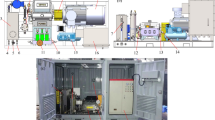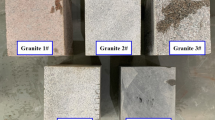Abstract
Abrasive water jet is widely used in the field of deep hard rock cutting. To accurately and quantitatively evaluate the implementation effect of repeated cutting hard rock by jet, the ratio of the jet cutting speed to the cutting times is defined as an index to evaluate the rock-breaking effect and efficiency, and laboratory experiments of repeated cutting granite by abrasive water jet under different horizontal stress are carried out. The obtained results show that the increase of rock horizontal stress leads to a rougher cutting surface of the abrasive jet, the average growth rate of roughness is 34.8 and 15.8%, respectively, and increases the specific energy consumption rate of the rock breaking, the average growth rate of specific energy consumption is 11.8 and 38.9%, respectively. When the repeated cutting method is used to break rock, as the ratio of the cutting speed to the cutting times increases, the cutting surface roughness and the specific energy consumption of rock breaking decrease first and then increase. When the cutting speed is 9 mm/s and the cutting is repeated for 3 times, the breaking effect and efficiency are the best. Under the combined action of axial high-speed impact, radial rotary grinding, and water wedge cracking, the local mineral particles in the slot may undergo trans-granular or inter-granular fracture, which eventually evolves into spalling and macro-damage of mineral particles.
Highlights
-
The variation of geometric parameters of slot cut by abrasive water jet with different horizontal stress and repeated cutting times is analyzed.
-
The surface roughness changes after repeated jet cutting were analyzed using three-dimensional morphological scanning.
-
The micro morphological characteristics of the slot surface under repeated cutting by abrasive water jet are described.
-
The results could provide theoretical basis and production guidance for hydraulic cutting and breaking of deep hard rock.
















Similar content being viewed by others
Data availability
All data generated or analysed during this study are included in this published article.
Abbreviations
- \(Z\) :
-
The vertical elevation of the cutting surface
- \(JR\mathrm{C}\) :
-
The cutting surface roughness
- \(L\) :
-
The cutting length
- \({Q}_{w}\) :
-
The water flow
- \({Q}_{a}\) :
-
The flow of abrasive particles
- \({\omega }_{a}\) :
-
The abrasive mass concentration
- \({m}_{t}\) :
-
The total mass of the abrasive water jet
- \({\rho }_{a}\) :
-
The abrasive density
- \(c\) :
-
The flow coefficient
- \(d\) :
-
The nozzle diameter
- \(P\) :
-
The jet pressure at the nozzle outlet
- SE:
-
The rock-breaking specific energy
- \({Q}_{t}\) :
-
The total jet flow
- \({E}_{t}\) :
-
The total rock-breaking energy
- \(T\) :
-
The cutting time
- \(V\) :
-
The slot volume
- \({t}_{s}\) :
-
The cutting time
- \({v}_{a}\) :
-
The cutting speed under a single cut
- \({t}_{m}\) :
-
The cutting time in the repeatedly cutting process
- \({v}_{b}\) :
-
The cutting speed in the repeatedly cutting process
- \({h}_{1a}\) :
-
The slot depth of the jet when cutting once at a transverse velocity \({v}_{a}\)
- \({E}_{1a}\) :
-
The jet output energy when cutting once at a transverse velocity \({v}_{a}\)
- \({h}_{Nb}\) :
-
The kerf depth when cutting N times at the transverse velocity \({v}_{b}\)
- \({E}_{Nb}\) :
-
The jet output energy when cutting N times at the transverse velocity \({v}_{b}\)
- \(\gamma \) :
-
The specific weight of water
- \(Q\) :
-
The jet flow
- \(l\) :
-
The jet target distance
- \({k}_{1}\), \({k}_{N}\), \(\alpha \), \(\beta \), \(n\) :
-
The coefficients of the abrasive water jet
References
Bañon F, Sambruno A, González-Rovira L, Vazquez-Martinez JM, Salguero J (2021) A Review on the Abrasive water-jet machining of metal-carbon fiber hybrid materials. Metals 11(164):164
Chen R, Yao W, Lu F, Xia K (2018) Evaluation of the stress equilibrium condition in axially constrained Triaxial SHPB tests. Exp Mech 58(3):527–531
Cheng J, Wang Y, Wang L, Li Y, Hu B, Jiang Z (2021) Penetration behaviour of TBM disc cutter assisted by vertical precutting free surfaces at various depths and confining pressures. Arch Civ Mech Eng. https://doi.org/10.1007/s43452-020-00172-5
Cheng J, Yang S, Han W, Zhang Z, Jiang Z, Lu J (2022) Experimental and numerical study on the indentation behavior of TBM disc cutter on hard-rock precutting kerfs by high-pressure abrasive water jet. Arch Civ Mech Eng. https://doi.org/10.1007/s43452-021-00360-x
Engin IC (2012) A correlation for predicting the abrasive water jet cutting depth for natural stones : research article. S Afr J Sci. https://doi.org/10.4102/sajs.v108i9/10.692
Ge Z, Cao S, Lu Y, Gao F (2022) Fracture mechanism and damage characteristics of coal subjected to a water jet under different triaxial stress conditions. J Petrol Sci Eng 208:109157
Gong F, Si X, Li X, Wang S (2019) Dynamic triaxial compression tests on sandstone at high strain rates and low confining pressures with split hopkinson pressure bar. Int J Rock Mech Min 113:211–219
Haddad M, Zitoune R, Bougherara H, Eyma F, Castanié B (2014) Study of trimming damages of cfrp structures in function of the machining processes and their impact on the mechanical behavior. Compos B Eng 57:136–143
Hashish M, du Plessis MP (1979) Prediction Equations Relating High Velocity Jet Cutting Performance to Stand Off Distance and Multipasses. J Eng Indus 101(3):311–318
Iqbal A, Dar NU, Hussain G (2011) Optimization of Abrasive water jet cutting of ductile materials. J Wuhan Univ Technol-Mater Sci Ed 26(1):88–92
Jang H, Kang S, Jang B (2014) Determination of joint roughness coefficients using roughness parameters. Rock Mech Rock Eng 47(6):2061–2073
Junkar M, Jurisevic B, Fajdiga M, Grah M (2006) Finite element analysis of single-particle impact in abrasive water jet machining. Int J Impact Eng 32(7):1095–1112
Kulatilake PHSW, Shou G, Huang TH, Morgan RM (1995) New peak shear strength criteria for anisotropic rock joints. Int J Rock Mech Mining Sci Geomech Abstracts. https://doi.org/10.1016/0148-9062(95)00022-9
Li X, Wang S, Ge S, Malekian R, Li Z (2017) Numerical simulation of rock fragmentation during cutting by conical picks under confining pressure. Comptes Rendus Mécanique 345(12):890–902
Li L, Wang F, Li T, Dai X, Xing X, Yang X (2020) The effects of inclined particle water jet on rock failure mechanism: experimental and numerical study. J Petrol Sci Eng 185:106639
Liu J, Cao P, Liu J, Jiang Z (2015) Influence of confining stress on fracture characteristics and cutting efficiency of TBM cutters conducted on soft and hard rock. J Cent South Univ 22(5):1947–1955
Liu S, Cui Y, Chen Y, Guo C (2019) Numerical research on rock breaking by abrasive water jet-pick under confining pressure. Int J Rock Mech Min 120:41–49
Liu S, Zhou F, Li H, Chen Y, Wang F, Guo C (2020) Experimental investigation of hard rock breaking using a conical pick assisted by abrasive water jet. Rock Mech Rock Eng 53(9):4221–4230
Liu L, Li R, Qin H, Sun W (2021) Experimental SHPB study of limestone damage under confining pressures after exposure to elevated temperatures. Metals-Basel 11(10):1663
Lu Y, Tang J, Ge Z, Xia B, Liu Y (2013) Hard rock drilling technique with abrasive water jet assistance. Int J Rock Mech Mining Sci 60:47–56
Ma D, Ma Q, Yuan P (2017) SHPB tests and dynamic constitutive model of artificial frozen sandy clay under confining pressure and temperature state. Cold Reg Sci Technol 136:37–43
Momber AW, Kovacevic R, Ye J (1995) The fracture of concrete due to erosive wear by high velocity water flow. Tribol T 38(3):686–692
N. B, V. C, (1978) The shear strength of rock joints in theory and practice. Rock Mech Felsmechanik Mécanique Des Roches 10:1–2
Pahuja R, Ramulu M, Hashish M (2019) Surface quality and kerf width prediction in abrasive water jet machining of metal-composite stacks. Compos B Eng 175:107134
Qiang C, Li L, Wang X, Guo C (2020) Study on the mechanism for sparks in cutting metal with abrasive suspension water jet. Int J Adv Manufact Technol 106(1–2):417–430
Saleem M, Bougherara H, Toubal L, Cénac F, Zitoune R (2013a) Analysis of stresses in CFRP composite plates drilled with conventional and abrasive water jet machining. Mater Sci Forum 763:127–143
Saleem M, Toubal L, Zitoune R, Bougherara H (2013b) Investigating the effect of machining processes on the mechanical behavior of composite plates with circular holes. Compos A Appl Sci Manuf 55:169–177
Singh MK, Trehan R, Gupta A (2021) Application of grey approach to enhance the surface properties during awj machining of marine grade inconel. Adv Mater Process Technol 7(3):429–445
Thangaraj M, Ahmadein M, Alsaleh NA, Elsheikh AH (2021) Optimization of abrasive water jet machining of SiC reinforced aluminum alloy based metal matrix composites using Taguchi–dear technique. Materials 14(21):6250
Wang S, Yang F, Hu D, Tang C, Lin P (2021) Modelling and analysis of abrasive water jet cutting front profile. Int J Adv Manufact Technol 114(9–10):2829–2837
Xiao S, Ren Q, Guan R et al (2021) Theoretical and experimental investigation on fracture response of coal impacted by high-velocity water jet. Energy Rep 7:3210–3224
Yang G, Bi J, Li X, Liu J, Feng Y (2020) SHPB testing and analysis of bedded shale under active confining pressure. J Eng 2020:1–8
Zhai SF, Cao SH, Gao M, Feng Y (2019) The effects of confining stress on rock fragmentation by TBM disc cutters. Math Probl Eng 2019:1–13
Zhang S, Huang Z, Wang H et al (2019) Experimental study on the rock-breaking characteristics of abrasive liquid nitrogen jet for hot dry rock. J Petrol Sci Eng 181:106166
Acknowledgements
We acknowledge the financial support from the National Natural Science Foundation of China (No. 52074045, 52274112), and the Project No.2021CDJCGJ010, supported by the Fundamental Research Funds for the Central Universities. Furthermore, our deepest gratitude goes to the anonymous reviewers for their careful work and thoughtful suggestions that have helped improve this paper substantially.
Author information
Authors and Affiliations
Contributions
ZG: Conceptualization, Methodology, Supervision. JS: Conceptualization, Formal analysis, Writing—original draft. ZZ: Validation, Visualization, Investigation. ZL: Resources, Data Curation. LL: Data curation, Reviewing and Editing. CC: Writing—Reviewing and Editing. CS: Writing—Reviewing and Editing.
Corresponding author
Ethics declarations
Conflict of Interest
The authors declare that they have no known competing financial interests or personal relationships that could have appeared to influence the work reported in this paper.
Additional information
Publisher's Note
Springer Nature remains neutral with regard to jurisdictional claims in published maps and institutional affiliations.
Rights and permissions
Springer Nature or its licensor (e.g. a society or other partner) holds exclusive rights to this article under a publishing agreement with the author(s) or other rightsholder(s); author self-archiving of the accepted manuscript version of this article is solely governed by the terms of such publishing agreement and applicable law.
About this article
Cite this article
Ge, Z., Shangguan, J., Zhou, Z. et al. Investigation of Fracture Damage and Breaking Energy Consumption of Hard Rock Repeatedly Cut by Abrasive Water Jet. Rock Mech Rock Eng 56, 3215–3230 (2023). https://doi.org/10.1007/s00603-023-03230-5
Received:
Accepted:
Published:
Issue Date:
DOI: https://doi.org/10.1007/s00603-023-03230-5




